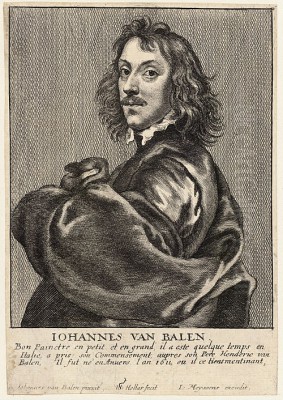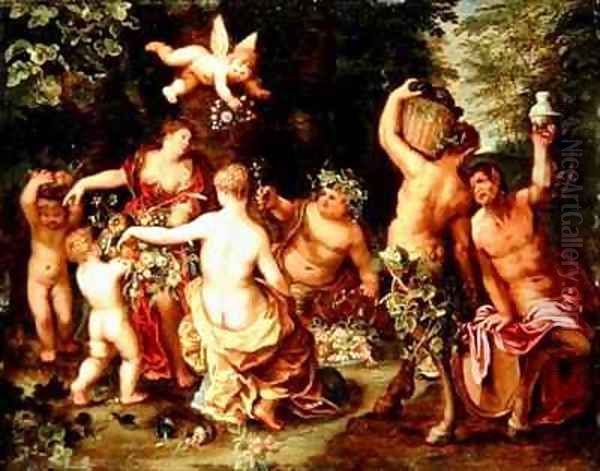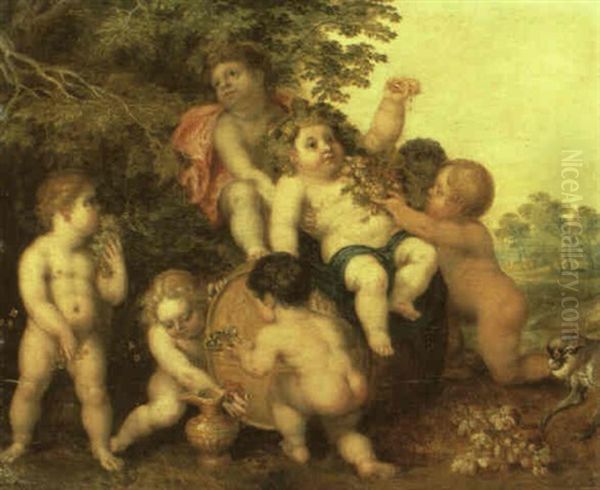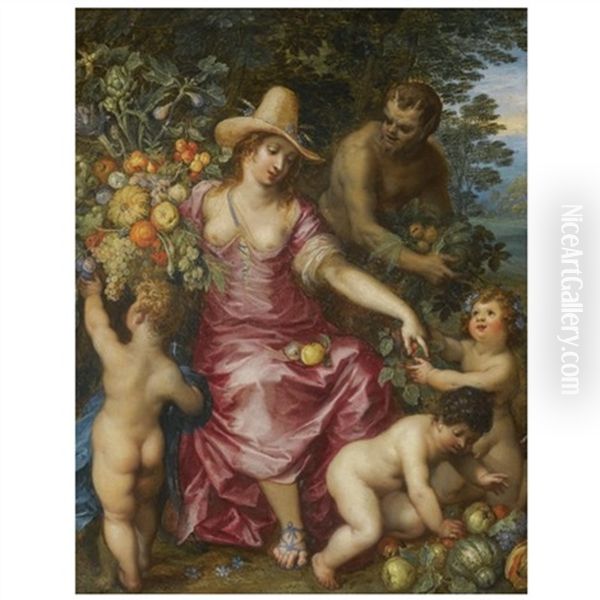
Hendrik van Balen the Elder stands as a significant figure in the rich tapestry of Flemish Baroque painting. Active primarily in Antwerp during the late 16th and early 17th centuries, he carved out a distinct niche for himself as a painter of refined mythological and religious scenes, a sought-after collaborator, and an influential teacher. Born circa 1575 and passing away in 1632, his lifespan coincided with a golden age of art in the Southern Netherlands, placing him amidst contemporaries like the towering Peter Paul Rubens and his own future pupil, Anthony van Dyck. Van Balen's contributions, particularly his elegant figure painting and his role within the collaborative artistic environment of Antwerp, merit close examination.
Early Life and Artistic Formation in Antwerp
Hendrik van Balen was born in Antwerp, the bustling artistic and commercial heart of the Spanish Netherlands, around 1575. The city provided a fertile ground for artistic development, steeped in a tradition that was increasingly embracing the dynamic energy of the Baroque style, largely imported from Italy but adapted with a unique Flemish sensibility. His artistic journey began formally under the tutelage of Adam van Noort, a respected painter who notably also counted the young Peter Paul Rubens among his pupils around the same period. This shared pedagogical lineage hints at the interconnectedness of the Antwerp art scene.
Van Balen proved to be a capable student, mastering the fundamentals of drawing and painting. His progress was officially recognized in 1593 when he was accepted as a master into the prestigious Antwerp Guild of Saint Luke. This membership was crucial, granting him the right to establish his own workshop, take on apprentices, and sell his works independently. It marked the beginning of a long and productive career centered entirely within his native city, where he would remain a respected member of the artistic community until his death.
Artistic Style: Elegance, Myth, and Venetian Echoes

Van Balen developed a distinctive style characterized by elegance, refinement, and a preference for mythological and religious subjects, often depicted on a relatively small scale suitable for cabinet paintings. He became particularly renowned for his skill in rendering the human form, especially graceful, often idealized nudes that populate his mythological scenes. His figures are typically drawn with clarity and precision, possessing smooth skin and elegant postures, reflecting an influence perhaps stemming from late Mannerism but evolving towards a softer, more Baroque sensibility.
His colour palette was often bright and harmonious, employing rich hues that added to the decorative appeal of his works. Art historians note the influence of the Venetian School on his style, particularly evident in his earlier works. This might reflect a possible, though undocumented, trip to Italy, or absorption of Italianate trends prevalent in Antwerp, perhaps through prints or the works of artists like Hans Rottenhammer, whose style Van Balen's sometimes resembles. While capable of larger altarpieces, his forte lay in these more intimate, meticulously finished works that appealed to collectors.
He frequently explored themes from classical mythology, depicting gods, goddesses, and nymphs in idyllic landscapes. Religious narratives also formed a significant part of his output, treated with a similar elegance and attention to detail. His ability to handle complex multi-figure compositions was notable, showcasing his skill in arranging figures harmoniously within the pictorial space.
A Master Collaborator: The Antwerp Network
One of the defining features of Hendrik van Balen's career was his extensive engagement in collaboration, a common practice in Antwerp's efficient art market. Artists specialized, and combining talents often resulted in works of greater appeal and faster production. Van Balen, with his recognized expertise in figure painting, was a highly desirable partner for landscape and still-life specialists.
His most frequent and famous collaborations were with members of the Brueghel dynasty. He worked closely with Jan Brueghel the Elder, known for his detailed floral still lifes and paradise landscapes. In these joint efforts, Brueghel would typically paint the landscape, animals, and still-life elements, while Van Balen added the mythological or biblical figures, creating harmonious compositions that blended their respective strengths.
After Jan Brueghel the Elder's death in 1625, Van Balen continued this collaborative tradition with his son, Jan Brueghel the Younger. Together, they produced numerous works, often continuing the popular themes established with the elder Brueghel. Paintings like Diana and her Nymphs after the Hunt exemplify this partnership, with Van Balen's elegant figures set within Brueghel's lush woodland setting. The series depicting The Allegory of the Four Elements and works like An Allegory of Abundance are further testaments to their prolific joint output.

Beyond the Brueghels, Van Balen collaborated with other notable Antwerp masters. He worked with Frans Snyders, a leading painter of animals and market scenes (and also one of Van Balen's pupils), likely adding figures to Snyders' compositions. Another collaborator was the landscape painter Abraham Govaerts, with whom he created works such as Diana and Her Maids after the Hunt in a Woodland Landscape. These partnerships underscore Van Balen's central role within the cooperative network of Antwerp artists.
Signature Works and Thematic Range
While renowned for collaborations, Hendrik van Balen also produced significant works independently. His oeuvre demonstrates a consistent focus on mythological and religious narratives, executed with his characteristic refinement. Among his representative works, several stand out, showcasing his stylistic traits and thematic preoccupations.
The Baptism of Christ is a notable religious painting, demonstrating his ability to handle sacred themes with grace and compositional skill. This work, now housed in the Prado Museum in Madrid, likely features his typical elegant figures and careful attention to detail within a landscape setting (which might, even in independent works, show influence from landscape specialists or studio assistants).
Mythological subjects provided ample opportunity for Van Balen to display his mastery of the nude figure. Apollo and Daphne captures the dramatic moment of transformation from Ovid's Metamorphoses, rendered with elegance and dynamic movement. Similarly, Achilles Discovered in the Lap of Lycoredes depicts a scene from the Trojan War cycle, focusing on the interplay of figures and rich details.
The Adoration of the Virgin Mary represents his contribution to devotional imagery, likely treated with the same delicate touch and harmonious colouring found in his other works. While known for smaller cabinet pictures, Van Balen also undertook commissions for larger works, such as altarpieces. The source text mentions a Resurrection for the St. Jacobskerk in Antwerp as an example of his work in this larger format, demonstrating his versatility.
A particularly interesting work mentioned in the source material (section ②) is The Judgement of Paris, noted as a collaboration with Peter Paul Rubens. If accurate, this would be a significant connection, though other parts of the source material suggest a lack of direct documented interaction between the two masters. Such collaborations, especially involving major figures like Rubens, highlight the fluid boundaries of authorship in Antwerp workshops.
The Van Balen Workshop: A Crucible of Talent

Hendrik van Balen maintained a large and successful workshop in Antwerp, a testament to his reputation and the demand for his art. Like many successful masters of the period, he employed assistants and trained apprentices, contributing significantly to the education of the next generation of Flemish painters. His studio was known for its productivity and the quality of its output.
His most famous pupil was undoubtedly Anthony van Dyck. Van Dyck entered Van Balen's studio around the age of ten, receiving his foundational training there before moving on to become a key assistant in the workshop of Peter Paul Rubens. Van Balen's early guidance likely instilled in the young Van Dyck a sense of elegance and refinement that would remain characteristic of his later style, particularly in his portraiture and religious works. Rubens himself reportedly referred to Van Dyck as his "best pupil," highlighting the talent nurtured initially by Van Balen.
Another prominent student who emerged from Van Balen's workshop was Frans Snyders. Although Snyders would become famous primarily as a painter of animals, hunting scenes, and elaborate still lifes, his early training with Van Balen provided him with a solid grounding in the fundamentals of painting. Their later collaborations demonstrate a continued professional relationship built on mutual respect.
Van Balen also trained his own son, Jan van Balen (1611-1654), who followed in his father's footsteps as a painter, often working in a similar style and continuing the tradition of mythological and religious cabinet paintings. The Van Balen workshop, therefore, played a crucial role not only in producing art but also in shaping the careers of several key figures in 17th-century Flemish art.
Navigating the Antwerp Art World: Connections and Challenges
Hendrik van Balen operated within a dynamic and sometimes challenging art market. The collaborative system, while efficient, could lead to complexities regarding attribution. The close stylistic relationship between Jan Brueghel the Younger and his father, Jan Brueghel the Elder, coupled with the younger Brueghel's practice of sometimes signing works in a manner similar to his father or having assistants add signatures, created potential for confusion that persists among art historians today. Disentangling the precise contributions of Van Balen and his collaborators in joint works remains an area of scholarly study.

The art market also presented financial pressures. An anecdote concerning Van Balen's collaborator, Jan Brueghel the Younger, illustrates this. After inheriting his father's studio, the younger Brueghel faced difficulties and entered into a dispute with a dealer named Bernard Vermeersch, who allegedly attempted to damage the artist's reputation. While not directly involving Van Balen, this incident reflects the competitive environment and commercial realities that artists of the time navigated.
Despite these challenges, Van Balen appears to have maintained a successful career and a respected position. His connections within the Antwerp art community were extensive. He shared a teacher, Adam van Noort, with Rubens. He collaborated extensively with the Brueghels. He taught Van Dyck, who became Rubens's chief assistant. He also taught and collaborated with Frans Snyders. This places Van Balen at the nexus of several important artistic relationships.
Regarding his relationship with Peter Paul Rubens, the source material presents a nuanced picture. While Adam van Noort taught both artists, and Van Dyck served as a link between them, the provided text explicitly states (in section ③) that no direct records of interaction between Van Balen and Rubens were found in the searched documents. However, another section (section ②) mentions a collaborative Judgement of Paris. This suggests either conflicting source information or a relationship that, while perhaps not extensively documented in personal correspondence, may have included occasional professional interaction or workshop-level collaboration, common in Antwerp.
Legacy, Collections, and Enduring Significance
Hendrik van Balen the Elder died in his native Antwerp in 1632, leaving behind a substantial body of work and a significant legacy as both an artist and a teacher. His paintings, appreciated for their elegance, detail, and harmonious compositions, found their way into numerous collections across Europe during his lifetime and afterwards.
Today, his works are represented in major museums worldwide. The source material confirms the location of Diana and her Nymphs after the Hunt (a collaboration with Jan Brueghel the Younger) in the Museo Nacional de Bellas Artes in Buenos Aires, Argentina. His Baptism of Christ is held by the prestigious Prado Museum in Madrid, Spain.

The location provided for An Allegory of Abundance (in the gardens of the Château de Choisy related to Madame de Pompadour's sister) seems highly improbable for a 17th-century panel painting and may result from a misunderstanding in the source text; works of this title attributed to Van Balen and Brueghel are typically found in museum collections like the Mauritshuis in The Hague. The current whereabouts of other significant works, such as the Allegory of the Four Elements series, are not specified in the provided information, though examples are likely dispersed among various public and private collections.
Hendrik van Balen's enduring significance lies in his mastery of figure painting within the Flemish Baroque tradition, his prolific output of refined mythological and religious cabinet pictures, and his crucial role as a collaborator within the Antwerp school. Furthermore, his influence extended through his successful workshop, particularly through the early training he provided to giants like Anthony van Dyck and specialists like Frans Snyders. He remains an important figure for understanding the artistic production, collaborative practices, and pedagogical systems of Antwerp's golden age, standing as a respected master alongside contemporaries like Rubens, Van Dyck, Snyders, and the Brueghel dynasty.